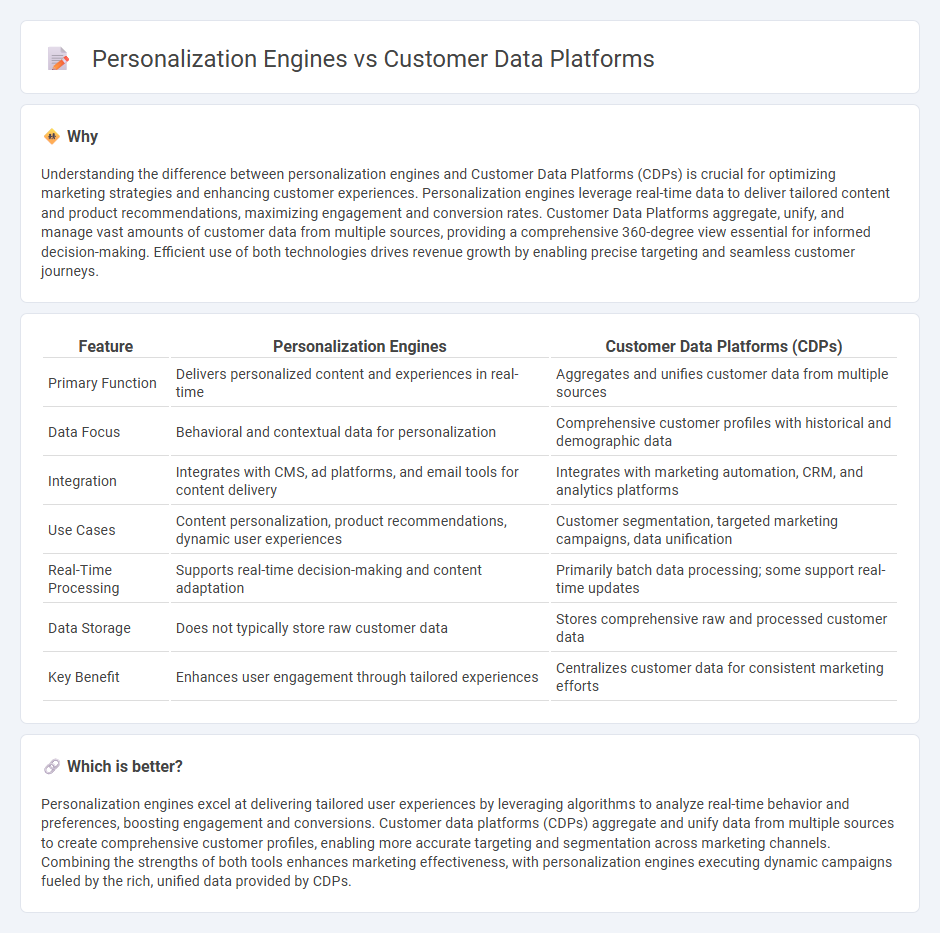
Personalization engines use real-time data and machine learning algorithms to tailor content and offers at the individual level, enhancing customer engagement and conversion rates. Customer Data Platforms (CDPs) aggregate and unify customer information from multiple sources into a single database, providing a comprehensive view for more informed marketing decisions. Explore how integrating personalization engines with CDPs can revolutionize your marketing strategy.
Why it is important
Understanding the difference between personalization engines and Customer Data Platforms (CDPs) is crucial for optimizing marketing strategies and enhancing customer experiences. Personalization engines leverage real-time data to deliver tailored content and product recommendations, maximizing engagement and conversion rates. Customer Data Platforms aggregate, unify, and manage vast amounts of customer data from multiple sources, providing a comprehensive 360-degree view essential for informed decision-making. Efficient use of both technologies drives revenue growth by enabling precise targeting and seamless customer journeys.
Comparison Table
| Feature | Personalization Engines | Customer Data Platforms (CDPs) |
|---|---|---|
| Primary Function | Delivers personalized content and experiences in real-time | Aggregates and unifies customer data from multiple sources |
| Data Focus | Behavioral and contextual data for personalization | Comprehensive customer profiles with historical and demographic data |
| Integration | Integrates with CMS, ad platforms, and email tools for content delivery | Integrates with marketing automation, CRM, and analytics platforms |
| Use Cases | Content personalization, product recommendations, dynamic user experiences | Customer segmentation, targeted marketing campaigns, data unification |
| Real-Time Processing | Supports real-time decision-making and content adaptation | Primarily batch data processing; some support real-time updates |
| Data Storage | Does not typically store raw customer data | Stores comprehensive raw and processed customer data |
| Key Benefit | Enhances user engagement through tailored experiences | Centralizes customer data for consistent marketing efforts |
Which is better?
Personalization engines excel at delivering tailored user experiences by leveraging algorithms to analyze real-time behavior and preferences, boosting engagement and conversions. Customer data platforms (CDPs) aggregate and unify data from multiple sources to create comprehensive customer profiles, enabling more accurate targeting and segmentation across marketing channels. Combining the strengths of both tools enhances marketing effectiveness, with personalization engines executing dynamic campaigns fueled by the rich, unified data provided by CDPs.
Connection
Personalization engines leverage customer data platforms (CDPs) to aggregate and analyze vast amounts of consumer information, enabling highly targeted marketing campaigns. CDPs unify data from multiple sources to create comprehensive customer profiles that personalization engines use to deliver relevant content and offers in real time. The synergy between personalization engines and CDPs drives improved customer engagement, higher conversion rates, and enhanced ROI in digital marketing strategies.
Key Terms
Data Integration
Customer data platforms (CDPs) excel in unifying customer data from multiple sources, ensuring a centralized and comprehensive profile for better audience segmentation and targeting. Personalization engines leverage this integrated data to deliver tailored experiences and real-time content adjustments based on user behavior analysis. Explore more to understand how effective data integration drives personalized marketing strategies.
Segmentation
Customer data platforms (CDPs) centralize and unify customer data from multiple sources to enable precise segmentation based on behavior, demographics, and purchase history. Personalization engines use these segmented datasets to deliver tailored content, offers, and experiences in real-time, optimizing engagement and conversion rates. Explore how these tools complement each other to enhance targeted marketing strategies.
Real-time Personalization
Customer data platforms (CDPs) centralize and unify customer information from multiple sources, enabling a single customer view that enhances segmentation and targeting. Personalization engines leverage real-time data and machine learning algorithms to deliver tailored experiences by dynamically adjusting content, offers, and recommendations based on current user behavior and preferences. Explore the benefits and technical distinctions between CDPs and personalization engines to optimize real-time personalization strategies.
Source and External Links
Customer Data Platform - A CDP is software that creates a unified customer database, accessible to other systems, by collecting and integrating data from multiple sources.
What is a Customer Data Platform (CDP)? - This page explains how CDPs allow businesses to unify customer data from various channels to build personalized customer experiences.
What is a Customer Data Platform (CDP)? - This resource outlines the essential features of a CDP, including data unification, identity resolution, and real-time activation for personalized experiences.
 dowidth.com
dowidth.com